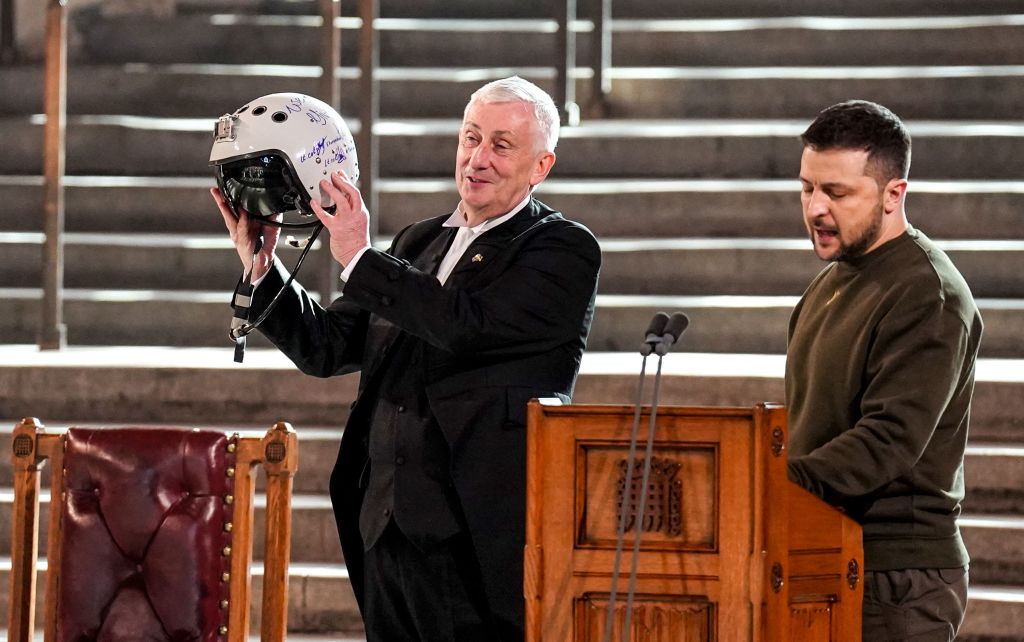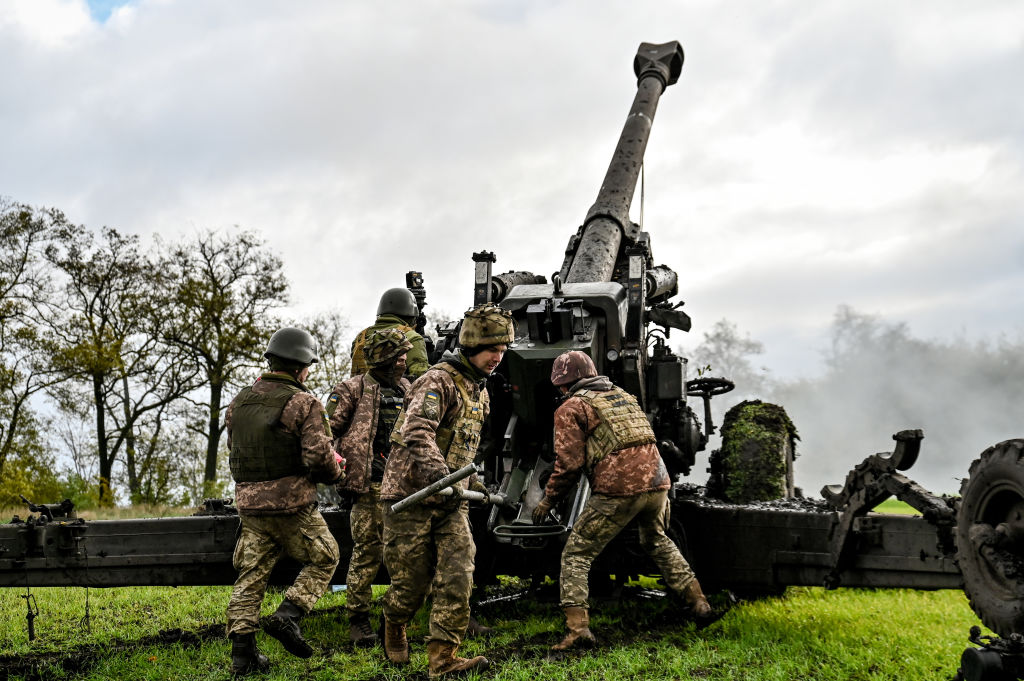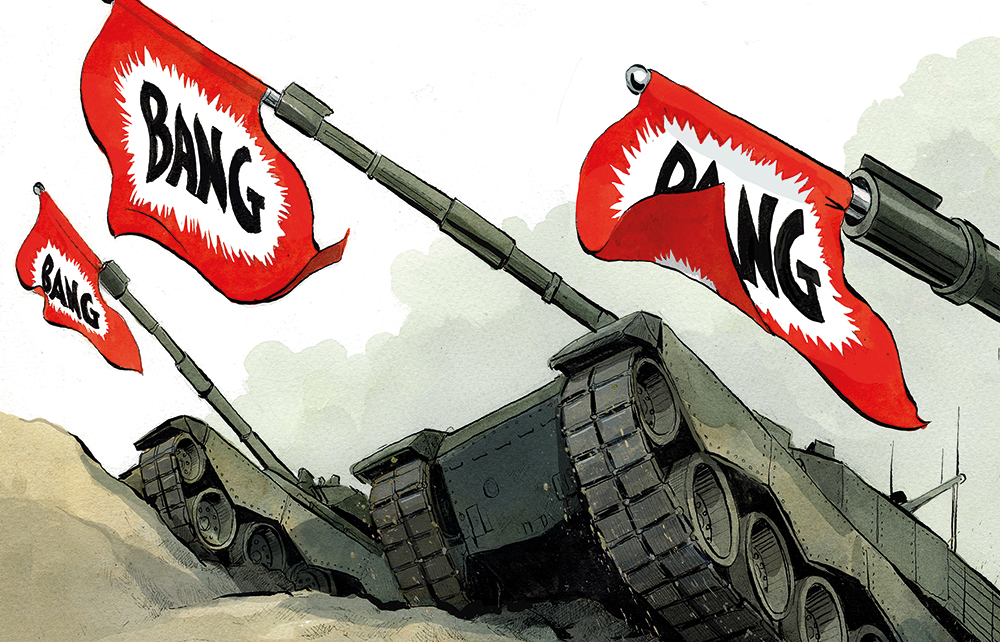Ayear ago on Friday, President Vladimir Putin unleashed blitzkrieg on Ukraine. It was an unprovoked assault that has so far led to more than 200,000 people being killed or wounded, but has failed in its intention of establishing Russian hegemony over its democratic neighbour. The West and much of the rest of the civilised world were shocked by the invasion, as well as being horrified and disgusted by the brutality of the Russian armed forces.
So it was with undisguised adulation that Ukraine’s President Volodymyr Zelensky was greeted by a standing-room-only crowd of parliamentarians in a freezing Westminster Hall this month, giving one of the most inspirational addresses to be heard in the 900-year history of that room. ‘Ukrainian soldiers are being trained in Britain,’ he said. ‘In particular, to operate Challengers, your main battle tanks. It’s a tank coalition in action, and I thank you, Rishi, for this powerful defensive step – for tank assistance.’ He thanked Britain no fewer than nine times for our military assistance in the war, and asked that it should be extended to what he called ‘powerful English planes’.

It is morally right and strategically sound for us to assist in a Russian defeat in Ukraine, but the British Army must be restocked with replacements for the huge amounts of equipment it has sent there. That is not presently happening, nor is the Treasury making the necessary provisions for that to happen in the future.
With 6,000 shells being fired by Ukraine each day, we in this country are down to less than a week’s supply
In almost all conflicts since the Napoleonic Wars, it has been heavy artillery that caused around two-thirds of battlefield casualties. Even in the Great War, artillery killed more people than the machine gun, despite our cultural concentration on the murderous power of the latter. In the Russo-Ukrainian war today, artillery fire causes 80 per cent of military casualties on both sides. Heavy artillery is thus a prerequisite for a modern army to be taken seriously on the world stage.
The British Army employed heavy artillery – by which is effectively meant 105mm and 155mm calibre guns – in Kosovo, both Iraq wars and Afghanistan. When Russia invaded Ukraine a year ago there were around 100 155mm guns here, enough for Britain to pack a serious punch. Yet with around 30 having been given to Ukraine, more than that entering obsolescence or unrepairable, and six in Estonia protecting our battalion there, the British Army is now down to too few operational heavy guns to conduct a foreign war.
Moreover, with 6,000 shells being fired by each side in Ukraine per day, we in this country are down to less than a week’s supply of shells. When Lord Northcliffe raised the warning over the famous Shells Crisis of May 1915, Britain at least had several hundred thousand in reserve. Today’s number is a small fraction of that. Jens Stoltenberg, head of Nato, recently said that Ukraine is using shells at a far faster rate than our ability to replenish. As a result, he said, the waiting time for large-calibre ammunition has increased from 12 to 28 months, so ‘orders placed today would only be delivered two-and-a-half years later’.
It is situations like this that Ben Wallace had in mind when he recently admitted the British Army has been ‘hollowed out and underfunded’ in recent years, a truly extraordinary statement for a serving defence secretary to have made in public. It echoes the statement last month of a ‘senior American general’ – and by all accounts it was a very senior American general – to the effect that the British Army was ‘no longer regarded as a top-level fighting force’.
Although the Ministry of Defence’s last Integrated Review correctly identified Russia as the most acute threat to British security, its other key emphases – on science and technology, a tilt to the Indo-Pacific region, the importance of cyber, nuclear and submarines, a new-generation fighter plane, and so on – while all important in themselves, have been used by Whitehall’s most powerful department, the Treasury, to whittle money away from heavy artillery, tanks and other equipment the army now desperately needs.
The Integrated Review cannot be blamed for not predicting Putin’s invasion of Ukraine, but historically many of our post-war crises have come out of an ever clearer blue sky. Few predicted Kim Il-sung’s invasion of South Korea in 1950, the Cuban Missile Crisis, the Falklands invasion, Saddam’s assault on Kuwait, or the attack on the Twin Towers. ‘Surprises happen so often in history,’ Paul Wolfowitz, the former US deputy secretary of defense, remarked after 9/11, ‘that the surprising thing is that we’re still surprised by them.’ Having a reserve of heavy artillery and shells is the minimum needed to respond to such surprises.
Labour can point out that tens of billions have been stripped from defence spending since 2010
When confronted by criticisms over our present-day shells crisis, No. 10 always responds in the same way. It refers to ‘meeting the threats of tomorrow with a fully funded £242 billion ten-year equipment plan, and the largest defence budget in Europe’. Yet although we are indeed presently the largest, on projected spending levels that will not be true by 2025/26, when we will be at best fifth in Nato. France, Germany and other Nato countries are replacing the equipment they are sending to Ukraine in a way we are not.
Furthermore, the £242 billion is divided between nuclear, submarines (for our new Aukus commitments), the new aircraft carrier fleets and the next-generation Tempest jetfighter. Funding these forces real-term cuts in the army’s projected budgets. Money has been promised for the modernisation of the army but will not arrive until the mid- to late 2020s, at best. Spending money on nuclear, submarines and jets that will not be delivered until the 2030s and 2040s does not help a hollowed out army which is today being asked to send yet more weapons to Ukraine, without any promises for replacement.
The Treasury has allocated just £2.3 billion for all three services to replenish stockpiles denuded by the Ukraine war. But General Sir Richard Barrons, former head of the Joint Forces Command, estimates it would cost £3 billion to do so for the army alone. Ben Wallace has asked for an extra £10 billion over the next two years, but there is no indication his voice resonates over that of the Treasury at No. 10. BAE Systems in the North-East and Wales does an excellent job producing shells for our 155mm and 105mm guns, but a single 155mm gun costs up to £10 million.

The Treasury’s fightback against providing extra money relies on media leaks about the large sums that the armed forces have supposedly wasted on projects such as the Ajax armoured vehicle, the Project Mensa warhead assembly facility, the Morpheus communications IT system and updating Trident. Yet even if all its accusations were true and fair – and not all are – it still would not justify withholding money from restocking the army with relatively low-tech equipment such as 155mm guns and shells that have been proved to work, and without which the army cannot fight a war.
Strong national defence has been seen as an instinctively Tory issue for well over a century, but, as Tony Blair showed over law and order and Keir Starmer is attempting to show over fiscal prudence, Labour is more than capable of stealing the Tories’ clothes over issues hitherto considered safe Conservative territory. At the next election, Labour can point out that tens of billions have been stripped from defence spending in real terms since 2010 and that the army will have shrunk to 73,000 from 103,000 when the party was last in power.
Although robots and AI do imply a need for fewer troops, as Zelensky himself has pointed out, when faced with numerical disadvantage on the battlefield, Russian quantity can turn into quality. Moreover, the Ukraine war has shown that tanks can only operate effectively when supported by infantry. Compared with Poland’s 900 tanks, the British Army is now down to 158 operational Challenger 2s, very close to the point where it loses the necessary critical mass and resilience necessary to fight as a serious force. The Challenger 3 will come online in 2028/29, but that is half a decade away.
Labour has yet to enunciate its defence spending plans. But were it to promise to end the shells crisis and plug other gaps, an important plank in the Conservative electoral platform could be removed forthwith. By promising to end the army’s hollowing out, it could be an open goal for Labour to pose as the patriotic party on national defence. With a major land war raging in Europe, Labour might even point out that defence did not feature in the Prime Minister’s list of five priorities for government.
Furthermore, with our commitment to Estonia being increased from a battalion to a brigade shortly – from around 1,000 to more than 5,000 soldiers – the protection of only six heavy guns would be seen as grossly inadequate should it ever be put to the test. History would not forgive a government that sent British troops into the field without proper protection.
It is not impossible to conceive Putin being replaced by a Russian regime even more revanchist. The Integrated Review was predicated upon a Russia that acted rationally, but what if it did not? Russia has already put its defence industry on to a total war footing, and has so far committed only 1.5 per cent of its manpower to fighting in Ukraine, yet the British Treasury is still not putting in the necessary ordnance contracts to protect our troops in Estonia effectively.
Whether Russia wins or loses in Ukraine, it is hard to see how it will not be more vicious, bitter and dangerous than it was before the invasion. Of course, it’s fiendishly hard for any government to find the billions necessary to fight a full-scale proxy war during a cost-of-living crisis, but the money must be found if we want to continue supporting Ukraine and simultaneously retain the capacity to fight a land war ourselves one day. Next month’s Budget would be the time to decide whether, a year after the invasion of Ukraine, Rishi Sunak really does intend to fight the Second Cold War on the cheap.






Comments